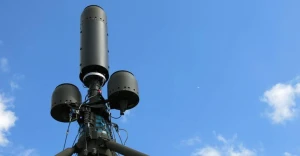
IAEA team inspects ZNPP cooling tower after fire, assesses damage
On August 12, International Atomic Energy Agency (IAEA) experts visited the cooling tower at the Russian-occupied Zaporizhzhia Nuclear Power Plant (ZNPP), where a fire had occurred the previous day. The exact cause of the incident remains undetermined
This information comes from the agency's latest report.
Experts believe it’s unlikely the fire originated at the base of the cooling tower. Their assessment suggests the damage likely occurred inside the tower, around the water nozzle distribution level, which is situated approximately 10 meters high.
The report mentions that the IAEA team requested access to the water nozzle distribution level, as they were only able to inspect the lower section. They also viewed the basin of water at the tower’s base from above and requested access to that area too.
However, the team was denied access to both locations, reportedly due to security concerns.
Additionally, the IAEA team observed charred internal equipment near the water nozzle distribution level. They also noticed traces of burnt plastic and fragments of concrete scattered across the basin of water.
The specialists collected samples, including burnt and melted plastic. The smell at the station, they noted, likely came from the burning plastic.
Despite the inspection, the team reported finding no evidence of tires or drone wreckage. They also noted that no debris, ash, or soot was present at the base of the cooling tower.
“The team has not been able to draw definitive conclusions on the basis of the findings and observations so far. The IAEA will continue its overall analysis after additional review and access to the water nozzle distribution level and the cold-water basin,” the agency stated.
The fire at Zaporizhzhia NPP on August 11
Russian forces ignited a fire at the temporarily occupied Zaporizhzhia nuclear power plant. On August 11, thick black smoke was seen rising from the site.
Yevhen Yevtushenko, head of the Nikopol district military administration, shared that, according to unofficial reports, Russian troops set fire to a large number of car tires in the cooling towers. This act was likely an attempt to provoke or instill panic among nearby residents.
Energoatom later confirmed the fire: "On August 11, 2024, around 8:00 p.m., a fire broke out at the technical water supply facility on the grounds of the Zaporizhzhia Nuclear Power Plant. The fire damaged cooling tower number one and other technological equipment."
The fire may have been caused by Russian troops' negligence or could have been a deliberate arson of the cooling tower, which is located about a kilometer from the station’s power units.
As of 12:30 a.m. on August 12, radiation levels at the station remained within normal limits, with no threat of radiation exposure to the population.
IAEA experts also observed thick dark smoke at the Zaporizhzhia NPP after the evening explosions. They suggested a possible drone attack on the cooling tower.
"Team was told by ZNPP of an alleged drone attack today on one of the cooling towers located at the site. No impact has been reported for nuclear safety," the IAEA stated.
Ukrainian President Volodymyr Zelenskyy remarked that the fire at the Zaporizhzhia NPP was visible from Nikopol, stressing that "as long as Russian terrorists control the nuclear plant, the situation is far from normal." He added that Ukraine expects the world to respond to yet another provocation by Russia.
Russia claimed that the fire at the ZNPP cooling system facility was allegedly caused by Ukrainian shelling.
Reference: A cooling tower is a specialized heat exchanger where heat from the water is removed primarily through evaporation in contact with the airflow.
- News











































